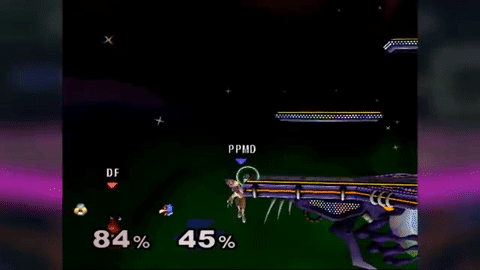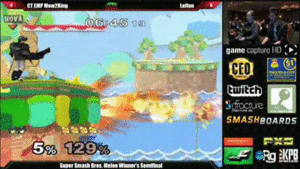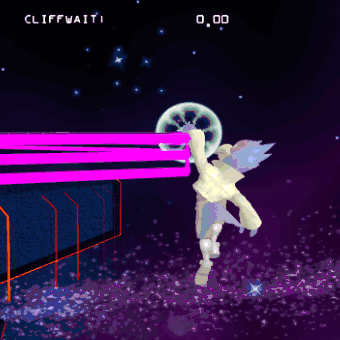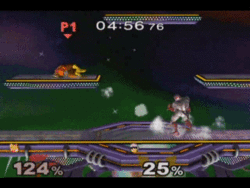Widely considered the best move in all of Melee as well as being an icon for the game, the shine is the down special of both Fox and Falco in Super Smash Bros. Not only is this move one of the best tools for combo starters and kills, it also has quite a few related techs. So let’s get right into it!
Overview

Formally known as the reflector, the shine was originally meant as a way to reflect projectiles. This property also multiplies both the speed and damage of the projectile by 50%; this might seem very useful but in high level play of melee this is probably the least popular use of the shine. So what makes this move so good?
First of all, this move comes out in one frame. This means as soon as the game registers the input, the hitbox comes out immediately. Second, it grants the user a frame of invincibility while the hitbox is out. In the GIF above the red is the hitbox, the yellow on a character means they can be hit, and the blue on a character means they are invincible. This can be more clearly shown in the picture below:

Third is the fact that you can jump out of shine, meaning you can cancel all ending lag by jumping while the shine is still out.
Techs
Jumping out of shine leads to a lot of different techs, including shinegrabbing. To understand shinegrabbing you first have to understand a jump-canceled grab. When a jump is inputted, there is a few frames of delay (usually from 3-8) in which the character starts the jump animation but doesn’t actually leave the ground. In Melee you can input a grab in these frames, meaning if you jump out of shine then input a jump-cancelled grab, you can effectively grab out of shine, executing a shinegrab.
Fourth is something called a multishine. One of the most notorious techniques in all of melee, this is the act of chaining multiple shines together by jump-cancelling a shine into another shine, and can (theoretically) be done indefinitely. I say theoretically as it is incredibly precise and demanding to execute, with fox’s multishine having a 7 frame cycle for the first shine to the second shine, then an 8 frame cycle from then on (roughly 1/12th of a second)) and Falco’s having a 9 frame cycle for the first shine to the second shine, then an 11 frame cycle from then on (roughly 1/17th of a second).

Frame by frame of fox preforming a doubleshine with inputs
Westballz preforming multishines in a handwarmer before a tournament set
Multishining is generally used for shield pressure, which is the act of attacking an opponents shield to make them act with the intention of following up with a punish. It is also widely used to show off, usually after a stylish kill, due to its notoriously precise input timing.
With all of these advantages it’s no wonder that it’s considered the best move in the game, but it gets better. There are a lot more Fox and Falco specific techs that show what this move is truly made of, and why it has such a huge reputation. Although this post is shorter than my usual posts, if i tried to cover all of these techs at once it would be my longest one by far, so look forward to the specifics next week! Thank you for reading! I’ll leave you with one of my favorite combos of all time from my favorite smash player of all time: Westballz with one of his many crazy long combos against Leffen at Beast 6. You can truly see how Falco’s shine can extend combos as well as end them, more on how that works next week!








